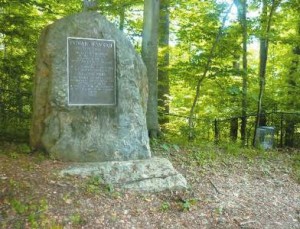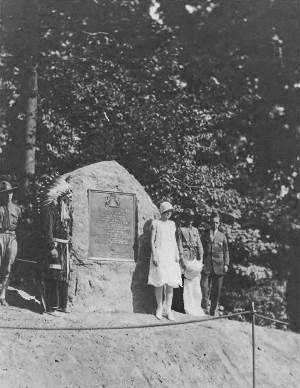by Karen Galle and Cory Kegerise
Hannah Freeman is not a name that you’ll find in most history books, though her story and her legend live on in southern Chester County. Known more popularly as “Indian Hannah”, Freeman is remembered in local lore as the last Lenni Lenape living in Chester County at the time of her death in 1802. She was born c.1730 on the Webb farm in Kennett Township not far from the Delaware border. Today the Webb farm is part of Longwood Gardens and her life and story are commemorated by a large stone monument erected in 1925 and rededicated in May 2014.
Indian Hannah’s story was recorded by the overseer of the poor in Chester County at the county poorhouse where she spent the final years of her life. This is a unique first person account of an unmarried Native American woman from the 18th century. Interestingly, it is not dissimilar from the life of a working poor woman of any race in a rural setting during this time period. She described her adult life as that of a migrant domestic worker. She primarily worked for board in a number of Quaker households in Chester County and earned a modest income by selling hand-made baskets and brooms.
We know now that Hannah was not, in fact, the last Native American in Chester County and that many individuals of Lenape descent live in or near the traditional Lenape homeland in Pennsylvania, Delaware, New Jersey and Maryland. Throughout the course of Hannah’s lifetime the population in Pennsylvania exploded as waves of European immigrants pushed west from the coast into the interior of the country. The massive immigration of non-native peoples forced the pockets of Lenape that remained in the region into the 18th century to either relocate or assimilate, obscuring many of the cultural and physical markers that signaled their presence. So, while Hannah may not have been the last of her people in Chester County, she may be seen as a representative of a fading nomadic lifestyle and a touchstone for understanding the complicated interactions between native peoples and European settlers during the country’s formative years.
In 1925 the Pennsylvania Historical Commission (PHC), predecessor to the expanded Pennsylvania Historical & Museum Commission (PHMC), collaborated with the Chester County Historical Society to erect a plaque on a large boulder to commemorate “Indian Hannah.” Pierre duPont donated a plot of land along the West Chester Road (Route 52) to the Commonwealth for the monument. The large granite boulder with inset bronze tablet was just one of the approximately 150 similar monuments erected by the PHC between 1913 and the mid-1930s. A large percentage of these plaques commemorated Native American subject matter, including individuals, tribes, settlements, and trails. Numerous monuments were erected to mark sites associated with the French & Indian War. When the State Archives, State Museum and the PHC combined in 1945 to form the PHMC, blue and gold painted aluminum markers on posts replaced the bronze plaques, and only about 25 of the granite monuments remain today.

Indian Hannah monument in its original location along the now abandoned Rt. 52.
In the late 1990s Longwood Gardens and PennDOT began planning for the relocation of Route 52 to improve traffic flow where it crossed Route 1. In 2012 the realignment of Route 52 to Longwood’s western boundary was completed and the Indian Hannah monument was orphaned along the abandoned roadbed. Recognizing that having the monument only accessible to Longwood’s visitors was contrary to the intent of the sponsoring parties and coupled with Longwood’s plans to restore the former roadway to meadow habitat, Longwood started a dialogue with PHMC, Chester County Historical Society, and Kennett Township about moving the marker to a more prominent and accessible location.
On May 15, 2014 Longwood Gardens hosted a rededication ceremony for the Indian Hannah monument in its new location on the grounds of the Longwood Meeting House, just outside the main entrance to the gardens. The ceremony was a recreation of the original September 5, 1925 ceremony, with the modern day counterparts of each of the major partners fulfilling the roles of their predecessors. Dennis Coker, Principal Chief of the Lenape Nation of Delaware offered the Invocation to the Great Spirit just as Chief Strong Wolf had done in 1925. Standing in for P.S. DuPont and PHC Chairman Henry Shoemaker were Nathan Hayward III, President of the Longwood Garden Board of Trustees and Serena Bellew, Director of the Bureau for Historic Preservation. Rob Lukens, President of the Chester County Historical Society offered historical notes on Indian Hannah and her place in contemporary society and Claire Sawyers from Swarthmore College recited the original poem penned for the occasion in 1925. Four descendants of the Webb family, including the son of Ms. Beulah Webb, who unveiled the original marker 89 years ago, were in the audience along with members of the Lenape Tribal Council, the duPont family, representatives of various preservation and historical organizations and local elected officials. There was even a bugler from a local Boy Scout troop on hand to close the ceremony with America the Beautiful.
Special thanks for the care and stewardship of this project go to Paul Redman, Director of Longwood Gardens along with members of his staff and the landscape architects who designed a fitting new setting for the monument. The Longwood Meeting House is now home to the Brandywine Tourism Information Center and the monument occupies a prominent corner of the property. Most importantly, it is in a location that is accessible to the public without entering the Longwood grounds, is highly visible, and is situated next to the visitor center, which ensures that Indian Hannah’s story will be available to more people than ever before.

Being a descendent of the Webb family, this makes me very proud. I grew up hearing stories of Indian Hannah.
I am a decendant of Hannah Webb. Her son was my great great grandfather, Thomas H Savery, Sr. I was told that at one time Indian Hannah lived on his farm called Ellerslie.
I can remember as a small boy the tale of an indian women but I never thout here name was Hannah not that she lived that long ako
Thank you I could not find it. Now I know where it is.
Longwood gift shop sells a book about Hanna.
The Boy Scout Bugler in the May 2014 re-dedication is Harrison N. Warren, Kennett Square Troop 24, who became an Eagle Scout in 2019 and graduated Kennett High School the same year.
The bragging about being a descendant of landowners is simply an accident of birth & not in my opinion something to be proud of. Hannah Freeman is a clue she was indeed married to a free man.
I hope to tell the real story of her commitment to Embreeville State hospital. Hannah was not feeble minded or insane but simply in the way.